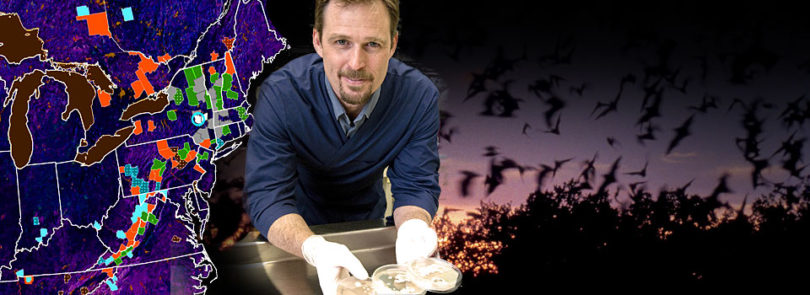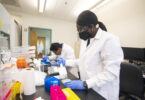Kevin Keel opens the refrigerator, lifts out several culture samples, and sets them on the stainless-steel table. The fuzzy white growth on the medium confirms what he and others in the lab already feared. The samples—taken from Kentucky bats —are positive for Geomyces destructans, a fungus that is killing bats in Canada and in the U.S. from New York to North Carolina. The confirmation brings to 17 the number of states involved—and there’s no end in sight.
Keel, a UGA veterinarian and wildlife pathologist at the Southeastern Cooperative Wildlife Disease Study, along with colleagues Justin Brown and Lisa Last, tested more than a hundred dead bats this past winter, verifying the fungus’s spread to new states—including four in the southeast since January.
First observed in the United States just five years ago, the fungus associated with white-nose syndrome (WNS) appears as white fuzz on the faces and wings of hibernating bats and rouses them prematurely from their winter torpor. Confused, sick—and possibly irritated by the fungus—they take wing, using up scant energy reserves when they should be holed up until warmer temperatures and ample food sources emerge in the spring. Their emaciated corpses, first found by recreational cavers and more recently by state wildlife biologists who are monitoring caves, often end up at SCWDS.
While it’s difficult to confirm the fungus’s source in the United States, Keel says the best theory at present is that it was brought from Europe by cavers or tourists who visited Howe Caverns near Albany, New York. It was there in 2006 that a caver first saw and photographed some white-nosed bats—and discovered several others dead on the cave floor.
The syndrome has so far been confirmed in nine bat species, including two (the Indiana and the Gray bat) that are already endangered. The mortality rate in some colonies has been greater than 90 percent—Keel calls WNS “the most devastating infectious wildlife disease we’ve ever seen.” And because many bats only produce one “pup” a year, scientists now fear that several once-common species may suffer a major population collapse that could wipe them out entirely in some regions.
That’s a serious concern given the critical role that bats play as insect predators, consuming half their weight or more in mosquitoes and other bugs each night, many of which would otherwise eat or damage crops. A new analysis, published in the April 1, 2011, issue of Science, estimated the value of bats’ pest-control services in the United States alone at more than $3.7 billion a year. The report also warned also warned that the United States will see “noticeable economic losses in the next 4 to 5 years as a result of WNS and other emerging threats to bat populations.”
In addition to eating millions of insects, bats also disperse seeds and pollinate some important agricultural crops, including bananas, vanilla beans, peaches, and avocados. Their waste, called guano, provides vital nutrients in cave habitats. And composted guano is a powerful organic fertilizer.
Officials in the Georgia Department of Natural Resources are monitoring caves but admit to feeling pretty helpless in light of the fungus’s swift march south. The state’s largest hibernacula—located in Rabun County—not far from caves with confirmed cases in North Carolina—houses some 5,000 tri-colored bats. “We seriously considered closing caves here,” said DNR’s Katrina Morris, a wildlife biologist who oversees bat conservation “but cavers voiced a lot of opposition. And because we need their help with monitoring and reporting, we ultimately decided against it.”
Funding for bat research is scarce, but scientists up and down the East Coast are patching together small grants from multiple sources or pursuing studies on their own. Several are working with infected bats to determine what conditions might mitigate the disease. Others are rehabilitating bats in labs to learn whether, once infected, they can recover, and if so, whether they are susceptible to future infection. Still others are using electron microscopy to study the lesions associated with the disease.
“I’ve learned that bat biologists are a dedicated, unpretentious group,” said Keel. “They’re sharing information and working together to fight this thing. And even though we haven’t had much good news for them, they’ve been a pleasure to work with.”








